These highlights chronicle the year 2024. The year runs generally
"backwards" on this page. In crediting records of vagrant or unusual birds, I always try to credit the finder(s) of the rarity. There will be times when complications arise with credit (e.g., one or more observers find a bird but others are the ones to actually identify it). There are times when a bird is properly identified only days later after photo review.
These summaries are not meant to be a "complete" record of birds of interest in MTY in any season — the reports forwarded to the Seasonal Editors of North American Birds magazine are intended to fill that niche — but, rather, these pages are of highlights of a portion of the year that were documented, in most cases, with photos.
The abbreviation "MTY" means "Monterey County"
in the text below. Text by Don Roberson. Photos on this page
are copyrighted by the photographers to whom they are
attributed, and may not be reproduced in any form (including
other web sites) without the express consent of the photographer. |
| |
 |
 A significant attraction of the 2024 Point Pinos Seawatch was an adult Nazca Booby, first spotted by Alison Vilag as it passed the Point late on 26 November, and then landed on the huge cormorant-pelican roosting rock to the south, which birders call "south gull roost" and the town calls "the great tidepool" (photo left is the booby on that rock, near dusk on 26 Nov, photo © Don Roberson). A significant attraction of the 2024 Point Pinos Seawatch was an adult Nazca Booby, first spotted by Alison Vilag as it passed the Point late on 26 November, and then landed on the huge cormorant-pelican roosting rock to the south, which birders call "south gull roost" and the town calls "the great tidepool" (photo left is the booby on that rock, near dusk on 26 Nov, photo © Don Roberson).
The next day, 27 Nov, after going off to sea to fish, the booby landed atop the Pt. Pinos rocks themselves (photo above, from 27 Nov, © Della Bossart). That was the day Todd Eastela drove 4 hours from Sacramento to add it to his on-going 2024 California Big Year, where it was his 500th state year-bird. Some of us began to call the booby "Todd." It was there on Pt. Pinos on 28 Nov, again on 29 Nov, and again on 30 Nov (but missed on 1 Dec). This may have been the most chaseable Nazca Booby in northern California, if not the entire State!
The Nazca Booby was split from the global Masked Booby after Pitman and Jehl (1998) documented differences in morphology, bill color, and plumage color, along with assortative pairing and habitat selection on islands where they both breed. Nazca Booby breeds primarily on the Galapagos Islands. In adults, a primary difference is the Masked Booby has a yellow bill while Nazca has an orange to reddish-pink bill; there are additional differences, and ageing the bird is necessary. For ageing and identification information before the split see (Roberson 1998); updated research after the split is in Pyle (2020).
Here, in MTY, before the 2000 split, we had two confirmed records of Masked Booby and two very probable records of juvenile Nazca Booby (Roberson 2002). Since then, particularly with warming oceans, we've had over 20 Nazca Booby of varying ages both offshore and along the coast, and only 4 additional records of Masked Booby. Three of those Masked Boobies were at Pt. Pinos, but starting in 2016, we've since had 8 records of Nazca Booby at Pt. Pinos between September-February, and one in July at Pt. Joe, Pebble Beach.
|
| |
 Monterey Audubon's professional seawatcher, Alison Vilag, back for her third consecutive year, began her 6 weeks of dawn-to-dusk surveys on 1 November. Throughout that month, she watched an adult female Cocos Booby passing the Point several times, and it, too, sometimes roosted there. She has had such other rarities as Wood Duck, White-winged Dove, and Short-eared Owl. On her off day once a week, those filling-in have spotted distant Sandhill Cranes (7 on 3 Nov; Brian Sullivan, Catherine Webb), and most impressive, a White Wagtail briefly landed at the Point, and then flew east, for those substituting on 17 Nov (Bill Hubick, Kyan Russell; photo, right, © K.S. Russell). Monterey Audubon's professional seawatcher, Alison Vilag, back for her third consecutive year, began her 6 weeks of dawn-to-dusk surveys on 1 November. Throughout that month, she watched an adult female Cocos Booby passing the Point several times, and it, too, sometimes roosted there. She has had such other rarities as Wood Duck, White-winged Dove, and Short-eared Owl. On her off day once a week, those filling-in have spotted distant Sandhill Cranes (7 on 3 Nov; Brian Sullivan, Catherine Webb), and most impressive, a White Wagtail briefly landed at the Point, and then flew east, for those substituting on 17 Nov (Bill Hubick, Kyan Russell; photo, right, © K.S. Russell). |
 Also back for its second consecutive year, was the adult Yellow-crowned Night Heron that provided the first MTY record when found on 5 Dec 2023 at Stillwater Cove, Pebble Beach; see more on the night-heron, and also about Alison and last year's seawatch, in the late 2023 summary. The night-heron wintered to 31 March 2024. This year the Yellow-crowned returned on 23 November, 12 days earlier than last year's discovery date, and took up roosting in the same line of cypresses, even though some had been heavily trimmed during the summer. Also back for its second consecutive year, was the adult Yellow-crowned Night Heron that provided the first MTY record when found on 5 Dec 2023 at Stillwater Cove, Pebble Beach; see more on the night-heron, and also about Alison and last year's seawatch, in the late 2023 summary. The night-heron wintered to 31 March 2024. This year the Yellow-crowned returned on 23 November, 12 days earlier than last year's discovery date, and took up roosting in the same line of cypresses, even though some had been heavily trimmed during the summer.
We don't know where the Black-crowned Night Herons that roost in the same cypresses go to breed in the summer. Some of us had guessed Point Lobos. On 25 Oct 2024, Rick Fournier surveyed the breeding heronry at two ponds on the privately-owned Packard Ranch, adjacent to Elkhorn Slough. He counted 73 Black-crowned Night Herons in that colony, and among them was an adult Yellow-crowned Night Heron! That colony had many fledglings this year. In December, Rick went back to Packard Ranch, and found all the night-herons gone. So, our working hypothesis is that this Pebble Beach Yellow-crowned Night Heron summered among the Black-crowns on Elkhorn Slough. |
 |
Two fine late November passerines attracted local birders. On 11 Nov, fireman Elliot Maiorana found a first-fall male Scarlet Tanager catching bees at his Cachagua Road fire station (photo left, 13 Nov © D. Roberson). It remained to 14 Nov. The timing was similar to other vagrant tanagers, but the inland location was unexpected. On 21 Nov, Melinda Nakagawa noted a Green-tailed Towhee at her Castroville feeder (photo right, 22 Nov © Rita Carratello). There is a chance it may winter. |
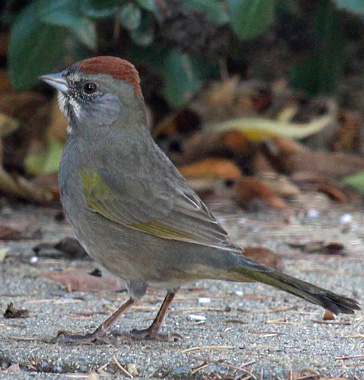 |
|
| |
| During October, eBird/Clements global checklist was updated with new taxonomic decisions. Two new species were added to the MTY checklist. One was splitting Siberian Pipit Anthus japonicus from American Pipit A. rubescens. In addition, eBird/Clements split Herring Gull into four species: European Herring Gull (Larus argentatus), American Herring Gull (L. smithsonianus), Vega Gull (L. vegae), and Mongolian Gull (L. mongolicus). What is now known as American Herring Gull is a common wintering bird in MTY offshore, at large tidal gull roosts on the coast, and at dumps and landfills. The split that affects us is Vega Gull. |
The two splits that add species to our local MTY list are vagrants. Vega Gull is from Siberia, and occurs regularly in Alaska. A few appear here, along the coast, with other gulls in late fall and winter. There are about 8 prior records in MTY, all between November and March, and most of them have been photographed. Just after formalizing eBird's decision, a juvenile Vega Gull was found and photographed on 2 Nov at Pt. Pinos (below left, photo © Brian L. Sullivan). Characters supporting Vega Gull plumage include extensive white scalloping on the upperwing coverts, an all-dark bill at this date, the pale patch formed by the inner primaries on the wing (as shown in all "Herring Gulls"), and extensive white at the base of the outer rectrices.
Siberian Pipit occurs in large groups of larks and pipits near the coast occasionally, and particularly when we get a number of vagrant Red-throated Pipits in October--November (both Red-throated and Siberian breed far north in Siberia). There are 6-8 prior records of Siberian Pipit in MTY, all in October to early November, most of which are currently under review by the California Birds Records Committee. There were at least 2 Siberian Pipit observations with American Pipits near Salinas in October; this Siberian Pipit, from 16 Oct, was photographed by Mark Chappell (below right, © M. Chappell). Characters supporting Siberian Pipit include white background color to underparts, bright pink legs, extensive black streaking below and down flanks, and broad, expanding malar stripe. |
|
|
| |

Overall, the numbers and diversity of "vagrant fall warblers" was well down from even the "average" fall migration; see a chart of average rates per fall in the autumn 2022 update. For example, some of our most likely Eastern vagrants have been Northern Waterthrush (6 per fall), Palm Warbler (19 per fall recently), Blackpoll Warbler (9 per fall), and Chestnut-sided Warbler (8 per fall). This autumn we had just 3 waterthrushes, 9 Palms, 7 Blackpolls, and 3 Chestnut-sideds. Probably the rarest warblers locally were a Canada Warbler at Big Sur River mouth on 28 Sep (Caitlin Chock, Logan Kahle) and a Virginia's Warbler at Laguna Grande on 1 Oct (Brian Sullivan).
However, fall 2024 was very good for diversity in flycatchers, vireos, pipits, orioles, and tanagers. Three very fine examples were found in October: a young male Vermilion Flycatcher at Pt. Pinos on 31 Oct, found by Bill Hubick, that stayed only one afternoon (photo right, © Karen Kreiger); a Blue-headed Vireo at Lagunita Mirada Park in Monterey on 26 Oct (below left; Carole & Larry Rose, photo 26 Oct © Carole Rose) and a young male Broad-billed Hummingbird in a neighborhood near Caledonia Park, Pacific Grove, found by Kate Spencer on 14 Oct (below right, photo 15 Oct © Don Roberson). The vireo was often elusive but some saw it to 28 Oct. The hummingbird remained to 16 Oct; this Broad-bill was the first ever for the Monterey Peninsula proper. Still, another young male Broad-billed Hummingbird was seen and described from Andrew Molera SP on 18 Oct (Allie Hicks). There are now 6 records of this Mexican hummingbird in MTY. |
|
| |
The best bird of fall 2024 was not on anyone's radar. When MTY observers opine about the next likely candidate for a first county record, thoughts tend to turn to Siberian vagrants, Mexican wanderers, or "overdue" birds (last year's first county record of Yellow-crowned Night Heron was very much on-our-radar because of prior records to both the north and south of us). I doubt that Steve Tucker was thinking along those lines as he took the trail back from the beach at Salinas River NWR on 20 October. He details the next few minutes in his eBird report: |
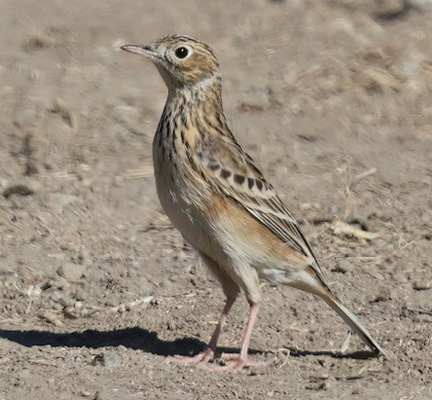 |
| "An absolute shock. While walking back from the beach, I saw a lone pipit a ways ahead of me on the trail along the edge of the saline pond. Its posture was very erect and it seemed extra skinny and buffy. Thinking of Sprague's Pipit but not actually believing it, I took some distant photos of the bird as it moved into some tall grasses next to the trail. Through the viewfinder I was surprised that it actually still looked like it could be a Sprague's Pipit. Miraculously it then flew closer to me and landed right out in the open within stone-throwing distance, where its identity was now obvious. After posing nicely for photos it flew off to the south, loudly calling an often doubled “squee! squee!” |
| |
| And so it came to be — our first MTY record of Sprague's Pipit ! (photo left, 20 Oct, © Steve Tucker). Yet, as described, it had just flown off. When we heard about the pipit through the birders' pipeline, many of us had a sinking feeling that the pipit had headed south, never to be seen again. Great find by Steve but would it possibly return? |
|
As luck would have it, the Sprague's Pipit did return to the same little patch of short grass and adjacent sand dunes time and time again, for five more days (full date span 20-25 Oct; photo right 22 Oct, © Don Roberson). In eBird there are 101 observers listed, many with photos of their own. My guess is that over 200 birders came for this celebrity; photo below (from 22 Oct) shows Rita Carratello's adult birding class on the trail among other birders. The happy couple (below right) are Fred Hochstaedter and Catherine Webb; this pipit was Fred's 400th bird in Monterey County.
There are only two prior Northern California records, both from SE Farallon Island (2 Oct 1979, 16 Oct 1987). Sprague's Pipit breeds in the high Great Plains in Canada, Montana, and North Dakota, migrating south to Texas and Mexico. A few winter regularly in southeastern Arizona, and only a tiny sprinkling winter in California's Imperial Valley. It is a difficult North American endemic to observe, and was a "lifer" for many observers. |
 |
|
|
| |
 |
Last fall brought a bonanza of Orchard Orioles, with at least 13 between 3 Sep-1 Oct 2023. This fall produced not a single Orchard Oriole, but, instead, a few rarer orioles were found in fruiting or flowering trees or cypresses. The rarest was this male Scott's Oriole in Karen Kreiger's yard near Mal Paso Canyon on 15 Oct (photo left, © K. Kreiger). It was the 7th record for MTY.
A fruiting "Australian Cherry" tree on Hawthorne Street in Monterey attracted multiple orioles in October. There was a late Hooded, and then on 19 Oct, a male Baltimore Oriole, found by Rob Treichler (photo below left, from 19 Oct © Carole Rose). Thereafter, one or more Baltimores came and went from the tree until 27 Oct. On 25 Oct, Ann Stockert photographed 3 Baltimores in the tree: the adult male, a young male, and a female. This is just one short of the record of four together near Esplanade Park, P.G., on 8-9 Oct 2001. Then, in November, another female or young male Baltimore Oriole brightened a red-blooming Corymbia ficifolia (red flowering gum) in the Pacific Grove cemetery from 24-26 October. Found by Mark Chappell, he obtained this colorful photo (below right, photo 25 Nov © M. Chappell). This makes four Baltimores for autumn 2024. |
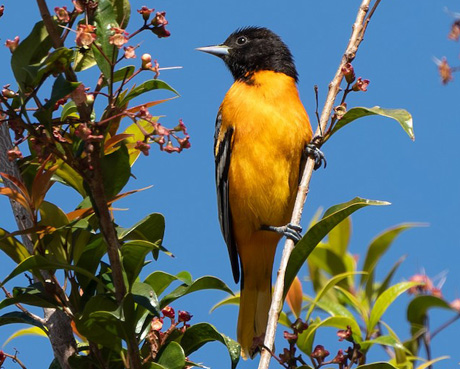 |
 |
|
| |
| In mid-September last fall, two Common Ringed Plovers were discovered at a restricted-access set of wastewater ponds. One was a juv and the other an adult; see that post of i.d. info. Quite remarkably, two (or more?) Common Ringed Plovers were found this fall at the ponds. The first one was an adult discovered by Todd Easterla 31 Aug (photo near right, © T. Easterla) that was seen off-and-on to 3 Nov (photo far right, 3 Nov © Steve Tucker). |
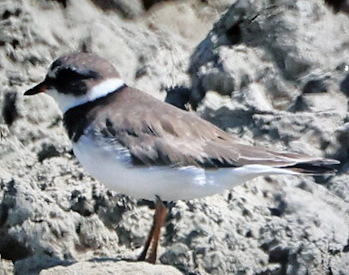 |
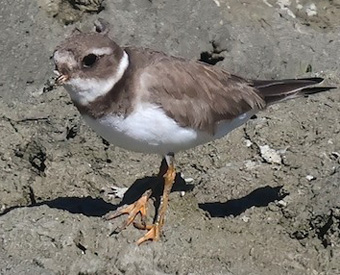 |
| Analysis of various characters suggest the same bird lingered for just over two months, but was found only irregularly as falcons and harriers scattered the plover and shorebird flocks widely. It seem quite likely that the adult may be last year's bird returning. In addition, a juvenile was present and photographed 7-8 Oct (Steve Tucker, Mark Chappell); that bird was heard on 7 Oct (and might have been the "heard-only" Ringed Plover on 5 Oct). A potential second juvenile was photo'd on 11 Oct (Mark Chappell) but not heard. The California Bird Records Committee (CBRC) will eventually sort out the number and date span of the plovers here. In addition, a juvenile stint, quite possibly a Little Stint, was present 26 Sep (Mark Chappell) but will also need to be evaluated by the CBRC. There were also huge flocks of American Pipits from 30 Sep-15 Oct, and among them were 3-5 Red-throated Pipit, almost all of them identified by flight calls overhead (at least one observer heard one on 5 different days, but no one knows if any were the same bird on multiple days). There were also 2-3 Siberian Pipit with the pipit flocks, and these were photographed on the ground. |

|
On 13 October, Todd Easterla, from Rancho Cordova, was present again, while on a State Big Year effort. He timed his visit well, as the pipit flocks had both a Siberian Pipit and he found this adult Red-throated Pipit (photo left, 13 Oct © Todd Easterla). I believe this is the first documented record of an adult in MTY. On this gloomy overcast day, a single dark swift foraged directly over one of the shallow ponds, and Todd Easterla and others (Brian Sullivan, Karen Kreiger) obtained photos of this Chimney Swift (photo right © Todd Easterla), It, too, is a significant MTY rarity. |
 |
|
Monterey Counnty attracts birders from around the world, but visitors from the Bay Area and beyond often time their visits to fall migration. Logan Kahle and Caitlin Chock timed their visit on 27-28 Sep very well. On 27 Sep, they found a very early Eastern Phoebe at Pt. Pinos (photo near right, 27 Sep © Caitlin Chock). This was the earliest fall record for MTY.
The next day (28 Sep) at Andrew Molera SP was excellent as well. Rare warblers included a Blackburnian and aforementioned Canada Warbler. They had a five vireo day, which included a Red-eyed Vireo along the Big Sur River, and, better yet, a Yellow-throated Vireo (photo far right, 28 Sep © Caitlin Chock). We only average about one a year, in either spring or fall. |
 |
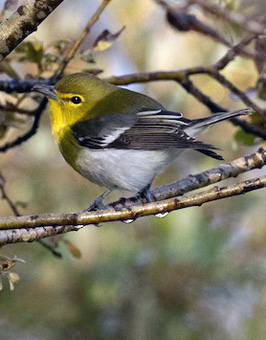 |
|
| Another Yellow-throated Vireo was singing along the Carmel River from 30 Aug-4 Sep (Brian Sullivan), and may have summered locally. Another super-rare vireo — Yellow-green Vireo — was in Steve Tucker's yard, in the Royal Oaks neighborhood near Elkhorn Slough, on 8 October. As for Eastern Phoebe, another was found by Michael Rieser near the Carmel River mouth on 20 Oct, and is still present in December, and may winter. |
 Mid-September 2024 had several very nice birds. On 14 Sep, Steve Tucker discovered this Great Crested Flycatcher at the El Carmelo Cemetery in Pacific Grove. As luck would have it, the bird stayed to 18 Sep; multiple photographers aimed cameras at it. Mark Chappell obtained this fine shot which even shows the tail pattern and wing formula (photo right, 14 Sep © Mark Chappell). This is the 11th Great Crested Flycatcher for MTY, all in fall migration, but the first for Pacific Grove. On 15 Sep, birders followed it until it flew over to the P.G. lighthouse trees within the Pt. Pinos hotspot, but quite quickly returned to it 'usual' haunts in the cemetery. Mid-September 2024 had several very nice birds. On 14 Sep, Steve Tucker discovered this Great Crested Flycatcher at the El Carmelo Cemetery in Pacific Grove. As luck would have it, the bird stayed to 18 Sep; multiple photographers aimed cameras at it. Mark Chappell obtained this fine shot which even shows the tail pattern and wing formula (photo right, 14 Sep © Mark Chappell). This is the 11th Great Crested Flycatcher for MTY, all in fall migration, but the first for Pacific Grove. On 15 Sep, birders followed it until it flew over to the P.G. lighthouse trees within the Pt. Pinos hotspot, but quite quickly returned to it 'usual' haunts in the cemetery.
Also on 14 Sep, Gary Dial found a nice male Summer Tanager in George Washington Park, Pacific Grove. It was a bit elusive for a time, and no one predicted that it would actual remain in the Park and the surrounding neighborhoods for a month; last seen 15 Oct. Mark Chappell snapped this shot on 3 Oct, after multiple visits photo below left, 3 Oct © Mark Chappell). [Later this fall, at least 4 other Summer Tanagers were scattered about.]
However, on 17 Sep, and before Mark Chappell had yet seen this Summer Tanager, he decided to point a big lens on a flock of Turkey Vultures overhead. Later that evening he was shocked to find that one of the "vultures" was actually a Zone-tailed Hawk! (photo below right, 17 Sep © Mark Chappell). This is the 5th MTY record. The others were Andrew Molera SP May 2001, in the lower Carmel Valley Nov 2002-Feb 2003, at Prunedale Nov 2005, and at Carmel Valley Village Nov 2007.
|
 |
 |
|

During the second week of September, an impressive passage of Arctic Terns was documented by seawatchers at Pt. Pinos. The half-day tally on 11 Sep was a minimum of 75 Arctic Terns, including 57 in less than an hour late in the afternoon (B.L. Sullivan, Paul Fenwick, Bill Hubick, et al.). A precursor to this flight was this adult Arctic Tern actually sitting on the sand at Seaside State Beach on 6 Sep, found by Amanda Preece (photo right, 6 Sep © Kyan Russell). Of our pelagic migrant small terns, Common Tern is quite often seen in flocks of Forster's or Elegant Terns at river mouths, particularly in fall migration, but Arctic is a really good find anywhere that is actually on-shore. |
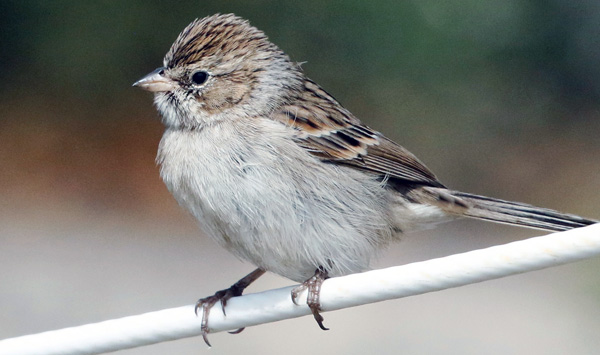
The first week of September is the traditional start of passerine migration. This hatch-year Brewer's Sparrow was the first nice landbird this autumn, found by Tom & Beth Hamel in short vegetation along the walking trail at Pt. Pinos (photo left, 4 Sep © Don Roberson). It was present from 4-6 Sep, and was very approachable, as is apparent in this shot as it sat on trailside borders that keep tourists on the designated pathway. |
| |
Literature cited:
- Pitman, R. L., and Jehl, J. R. Jr. 1998. Geographic variation and reassessment of species limits in the “Masked” Boobies of the eastern Pacific Ocean. Wilson Bull.110:155–170.
- Pyle, P. 2020. Molt, age, and identification of Masked and Nazca Boobies in California. Western Birds 51:129–149.
- Roberson, D. 1998. Sulids unmasked: Which large booby reaches California? Nat. Audubon Soc. Field Notes 52:276–297.
- Roberson, D. 2002. Monterey Birds, 2d ed. Monterey Audubon Soc., Carmel, CA.
I thank Rita Carratello and Michael Rieser for editorial comments on an earlier draft of this page.
|
|
Page created 1-15 Dec 2024
TOP
GO TO
HOME PAGE
TO MONTEREY
COUNTY
PAGE
TO BIRD
FAMILIES
OF THE WORLD
|

 Monterey Audubon's professional seawatcher, Alison Vilag, back for her third consecutive year, began her 6 weeks of dawn-to-dusk surveys on 1 November. Throughout that month, she watched an adult female Cocos Booby passing the Point several times, and it, too, sometimes roosted there. She has had such other rarities as Wood Duck, White-winged Dove, and Short-eared Owl. On her off day once a week, those filling-in have spotted distant Sandhill Cranes (7 on 3 Nov; Brian Sullivan, Catherine Webb), and most impressive, a White Wagtail briefly landed at the Point, and then flew east, for those substituting on 17 Nov (Bill Hubick, Kyan Russell; photo, right, © K.S. Russell).
Monterey Audubon's professional seawatcher, Alison Vilag, back for her third consecutive year, began her 6 weeks of dawn-to-dusk surveys on 1 November. Throughout that month, she watched an adult female Cocos Booby passing the Point several times, and it, too, sometimes roosted there. She has had such other rarities as Wood Duck, White-winged Dove, and Short-eared Owl. On her off day once a week, those filling-in have spotted distant Sandhill Cranes (7 on 3 Nov; Brian Sullivan, Catherine Webb), and most impressive, a White Wagtail briefly landed at the Point, and then flew east, for those substituting on 17 Nov (Bill Hubick, Kyan Russell; photo, right, © K.S. Russell). A significant attraction of the 2024 Point Pinos Seawatch was an adult Nazca Booby, first spotted by Alison Vilag as it passed the Point late on 26 November, and then landed on the huge cormorant-pelican roosting rock to the south, which birders call "south gull roost" and the town calls "the great tidepool" (photo left is the booby on that rock, near dusk on 26 Nov, photo © Don Roberson).
A significant attraction of the 2024 Point Pinos Seawatch was an adult Nazca Booby, first spotted by Alison Vilag as it passed the Point late on 26 November, and then landed on the huge cormorant-pelican roosting rock to the south, which birders call "south gull roost" and the town calls "the great tidepool" (photo left is the booby on that rock, near dusk on 26 Nov, photo © Don Roberson).  Also back for its second consecutive year, was the adult Yellow-crowned Night Heron that provided the first MTY record when found on 5 Dec 2023 at Stillwater Cove, Pebble Beach; see more on the night-heron, and also about Alison and last year's seawatch,
Also back for its second consecutive year, was the adult Yellow-crowned Night Heron that provided the first MTY record when found on 5 Dec 2023 at Stillwater Cove, Pebble Beach; see more on the night-heron, and also about Alison and last year's seawatch,








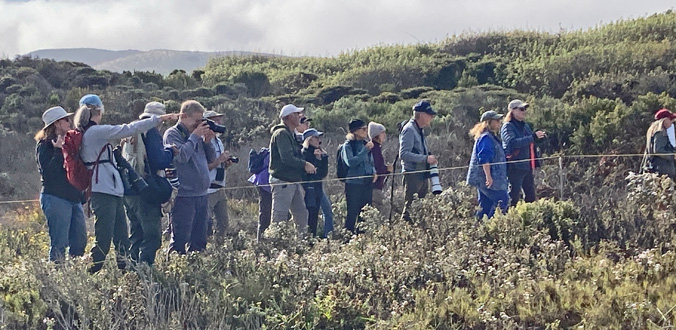










 Mid-September 2024 had several very nice birds. On 14 Sep, Steve Tucker discovered this Great Crested Flycatcher at the El Carmelo Cemetery in Pacific Grove. As luck would have it, the bird stayed to 18 Sep; multiple photographers aimed cameras at it. Mark Chappell obtained this fine shot which even shows the tail pattern and wing formula (photo right, 14 Sep © Mark Chappell). This is the 11th Great Crested Flycatcher for MTY, all in fall migration, but the first for Pacific Grove. On 15 Sep, birders followed it until it flew over to the P.G. lighthouse trees within the Pt. Pinos hotspot, but quite quickly returned to it 'usual' haunts in the cemetery.
Mid-September 2024 had several very nice birds. On 14 Sep, Steve Tucker discovered this Great Crested Flycatcher at the El Carmelo Cemetery in Pacific Grove. As luck would have it, the bird stayed to 18 Sep; multiple photographers aimed cameras at it. Mark Chappell obtained this fine shot which even shows the tail pattern and wing formula (photo right, 14 Sep © Mark Chappell). This is the 11th Great Crested Flycatcher for MTY, all in fall migration, but the first for Pacific Grove. On 15 Sep, birders followed it until it flew over to the P.G. lighthouse trees within the Pt. Pinos hotspot, but quite quickly returned to it 'usual' haunts in the cemetery. 


